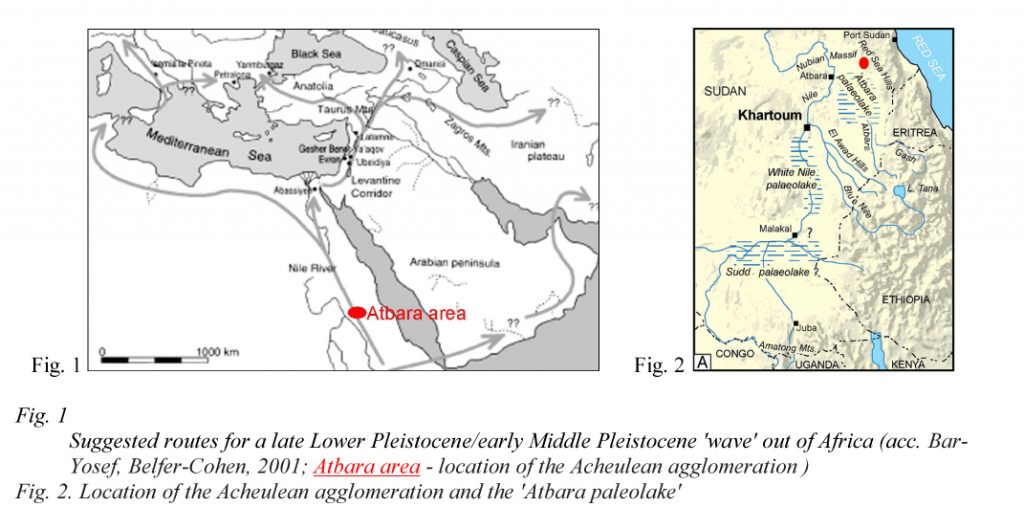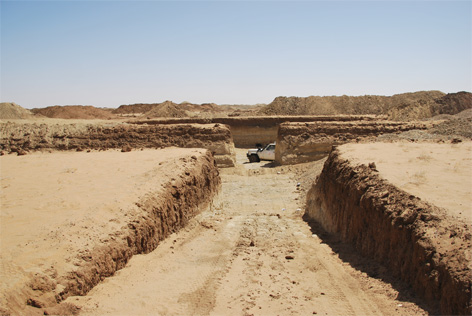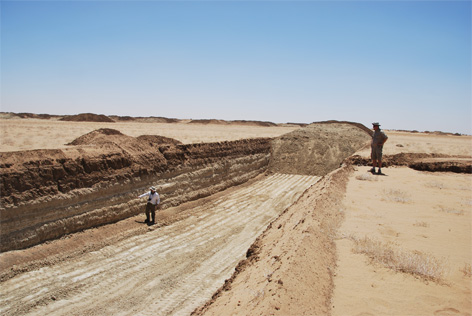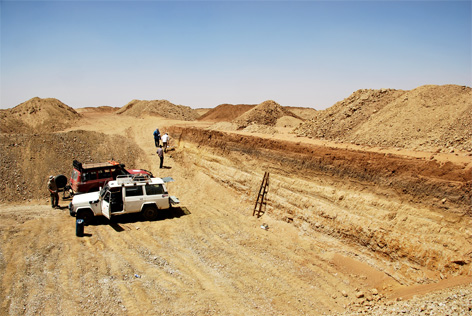Homo erectus on the path to Eurasia
Stratified sites agglomeration of Acheulean tradition in the Arabian Desert in Sudan
According to current evidence Pleistocene hominins left the African continent dispersing into Eurasia during at least two dispersal events. Out-of-Africa (I) refers to the early hominin dispersal prior to Homo sapiens (e.g. Homo erectus/ergaster).1 Different routes have been suggested for this migration of humans out of Africa, including the Mediterranean coast of North Africa, the Sahara, the Nile Valley, the Red Sea coast, and the Bab-el-Mandab Strait. At least one of these possible routes crossed Sudanese Nubia. The analyses of the role of Nubia and the Nile valley in this process have been already several times an element of the general debate of the migration from Africa.
We present the study of an agglomeration of Acheulean Industrial Complex localities in the Eastern Desert of Sudan far from the Nile valley, named EDAR (Eastern Desert Atbara River), suggesting the presence of yet another corridor(s) across Nubia leading the early migrations from the Nile and Atbara river system to the Red Sea coast. Complex of EDAR sites is located in the exposed areas of the gold mines/shafts in the lower reaches of the Atbara River, situated ca. 70 km from the town of Atbara. Placed within large Wadi el Arab stretching from the Red Sea Mountains to the Atbara River, EDAR sites are found within their original stratigraphic contexts. Preliminary results of EDAR sites study indicate the presence in the Eastern Desert of the latest African Acheulean as well as the early Middle Stone Age (MSA) remains of occupation situated in the fluvial environment of many braided river channels existed during the upper middle Pleistocene, ranging between MIS 7 (pluvial) and MIS 6 (interpluvial).
The aim of the research project is to investigate the nature of the settlement of human groups in the lately discovered agglomeration of stratified Acheulean sites within Hudi depression in the Arabian (Eastern) desert in Sudan. The study will outlines a picture of the activity of the hominid Homo erectus* (Anton 2003) within the period of about 0.8 – 0.3 million years ago in the enclave settlement situated on the potential migration route from East Africa to the Middle East and Europe (Fig. 1,2).
Lately discovered group of sites is located in the Arabian desert, about 80-100 km NE from Atbara city, within so called Hudi depression (Fig. 2). Agglomeration of sites has been initially investigated by Sudanese – Polish team in 2013 (survey) and 2014 (survey, test pits and documentation of geology within the outcrops). Initial reconnaissance proved a high scientific value of the area offering the research possibility of the early stages of human evolution, the phenomenon so called 'out of Africa’, which is one of several migrations of hominids from eastern Africa to Eurasia taking place ca. 0,8 Ma.
The core of the investigated area is an archaeological site – EDAR 6 (N 17 40 342 E 034 44 477) where the mentioned test pits confirming location of levels with Acheulean artifacts (down to the depth of 1,5 m) took place. Test excavations proved the stratigraphic character of the sites. Very useful for field observations, which is hardly to overestimate, are numerous outcrops located close by the archaeological sites – gold mines. They are located in many places allowing us to document the geological structure of the area as well as documenting archaeological artifacts in stratified context, i.e. choppers, hand axes, bones (Fig. 3-5). The initial observations within the outcrops and our test pits brought the first geological and archaeological conclusions.
Appearance of lithic artifacts produced by hominids of homo erectus/ergaster within the stratified sediments gives the unique opportunity for investigations of a good preserved remains from the beginnings
of human culture. Confirmed co-presence of lithics and mega-fauna animal bones (Elephantidae) gives potential for ecosystem’s research opportunity exploited by hominid populations within Hudi depression.
Preservation of ecofacts gives even additional potential chance for discovery of hominids remains. Stratigraphy within the mines and the stratified site EDAR 6 enable realization of paleogeographical research leading to paleoenvironmental reconstructions.
The principle research hypothesis for proposed project is that the newly discovered agglomeration of Acheulean sites in Sudanese hinterland is a remains of early hominid’s stop/stage on their path to Eurasia. The aim of the research will be not only the analyses of their activity but also reconstruction of the environment in which their existed. It will be achieved by multifaceted, interdisciplinary analyses and investigations.
Anton SC. 2003, Natural history of Homo erectus, American Journal of Physical Anthropology Supplement
37, 126–170.
* For the purpose of this abstract Homo erectus is considered to be synonyms to ‘Homo ergaster’ (and
also ‘Homo aff. erectus’ from Wood 1991) as well as to all specimens from the latest Lower Pleistocene and
MP of Africa that cannot be attributed to H. erectus.
ما زال فهمنا لقضية هجرة البشريات المبكرة من إفريقيا إلي أوراسيا ضعيفاً فيما يتعلق ببزوع الثقافة البشرية. خصوصاً المنطقة خارج إفريقيا الشرقية والأخدود الإفريقي العظيم والتي وجدت بها بقايا أثرية محفوظة جيداً مع قليل من الأدلة الأثرية على تحركات لمجموعات الهومواركتوس إلي الشمال. واحدة من تلك المواقع الأثرية اكتشفت مؤخراً في السودان وبدأ البحث فيها ممنهجاً وفق خطة بحثية.
هدف المشروع العلمي في هذه المنطقة للتعرف على طبيعة مستوطنات المجموعات البشرية المبكرة المكتشفة مؤخراً من خلال مواقع أثرية ذات تراصفات طبقية للعصر الأشولي في منخفض الهودي بالصحراء العربية في السودان. تركز الدراسة على تحديد صورة لنشاطات الهومواركتوس في الفترة من 0.8 – 0.3 مليون سنة مضت في منطقة تتوسط الطريق المقترح لخروجه من شرق إفريقيا إلي الشرق الأوسط وأوربا (شكل رقم).
سوف تسمح الأبحاث المتداخلة والمناهج المتعددة من التوريخ المطلق لآثار المستوطنات وإعادة تركيب البيئة القديمة للمنطقة المحيطة بالمواقع الأثرية والتباين الاقليمي. بالإضافة إلي دور منخفض الهودي (بحيرة البلايستوسين القديمة) في تكوين تاريخ وادي النيل. البقايا العظمية المرافقة للأدوات الأشولية، بجانب إمكانية دراسة عظام الحيوانات الكبيرة لعصر البلايستوسين تعطي الأمل في العثور على بقايا البشريات المبكرة نفسها.




